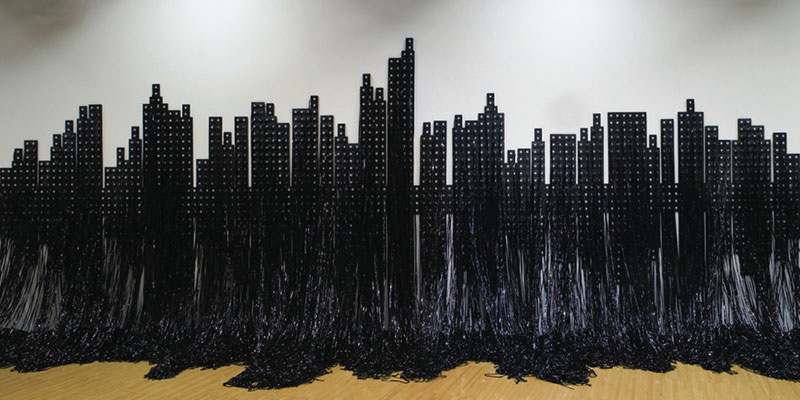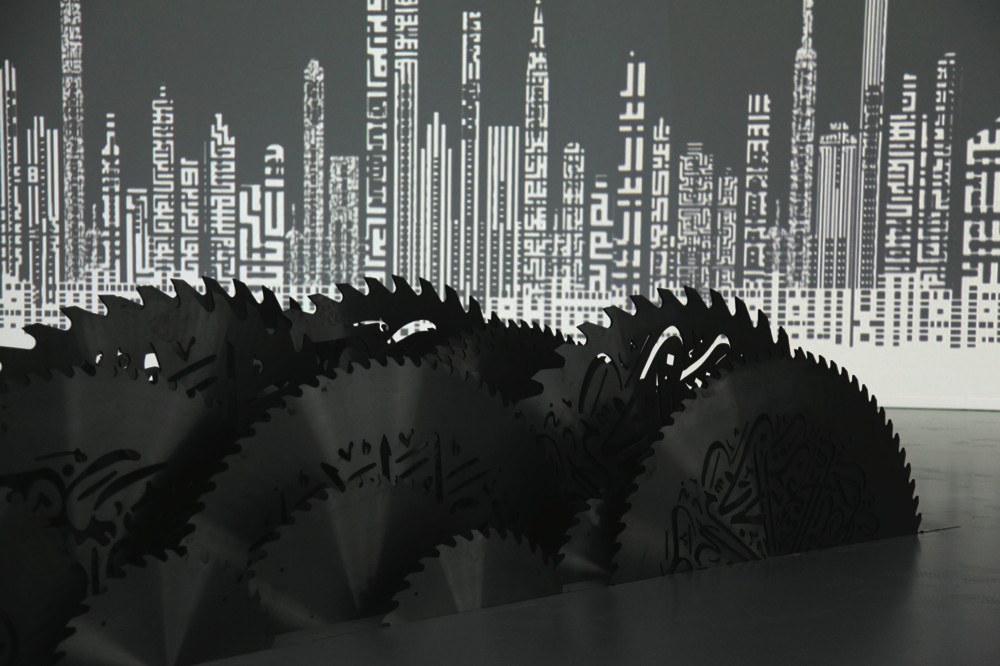Inventor and creator of images, Mounir Fatmi, born in Tangiers in 1970 shows his work world-wide. Polyglot, Multicard, and also film director, writer, calligraphist…The child from Tangiers, who decided one day to think for himself because his mother told him, “he who wears another’s clothes, goes naked” is linked, in his art and in his life to the cultural hybrid defined as the absolute value of our times. In art as in life: for the artist there is no difference. His life is work and his work is life; the desire for life and work mix together, they meld and exchange, reknown in work becomes reknown in life and the act of living becomes an act of culture.
Mounir Fatmi works. Works to create and show us ideas. But how to find the idea? Mounir loves the story of the man who searches in the light for that which he has lost in darkness. He searches in the light where apparently there is nothing, “since that which is there doesn’t interest me, that which interests me is that which is not there”. This apparent nothing is a situation, something which no one has yet seen; something invisible which the artist shows and which suddenly takes on a disproportionate importance. Like the parts of the censured Maroccan film, “A minute less of sun”, afterwards used to make another film which will become ‘The Scissors’. Or like objects forgotten on the roof of the family house in Tangiers. Fatmi remembers: “One day we were all there, all together, all the family – I went up on to the roof with my camera and there in a corner were some objects, like a Morandi still life, and so I started to take pictures…when my father came up to me he was astonished. “We are all here together, your brothers, your sisters, your nieces and nephews, we your parents, and here you are on the terrace taking pictures of rubbish?” And so I do ask myself, how do I give something to the living, to extract from my brain something which doesn’t yet exist, sometimes it is absurd…It is the artist who must ask himself ,with an intensity so sharp that it resembles pain, the impossible question: where do I get my ideas from? Where do the images I make come from? How does this collection of things I have in my mind work and where does the “incident” come from which will bind all these strange elements together to create the idea?”
The “incident” waited for, hoped for, welcomed? It is invoked from excessive activity and not for nothing Mounir Fatmi works like crazy. “Tiredness, the gathering of things, when I am close to an overdose of information, literature, images, and here in these shortcuts between realism and surrealism, something amazing happens…The idea is born like a virus: if it develops I am fucked. The the struggle begins with the project: to leave the virus to act, recognise it and then fight it swiftly, dominate it and give it the form I want. I have two weapons in this struggle: my arrogance- my conviction that I can confront the virus- and my ingenuity”. Often Fatmi resists the virus for a long time- as is the case in this vision of Jesus’ sex in the thousands of “Madonnas with Child” which he has observed, fascinated by the presence of the sex of the baby in the paintings which everyone looks at but no one sees. Twenty years of resistence in this case- and then suddenly the virus becomes a life project and Fatmi embraces it and starts to work on the idea, transforming it and thinking of nothing else – like the Morandi on the roof of the family house which makes him forget his own mother. Or the black leg which it would seem that he is the only one to see in the Beato Angelico painting, entitled “The cure of The Deacon Giustiniano”.
“Everyone looks at and discusses the Beato Angelico painting, talking about the imperfect way he represents perspective – I see this leg, this incredible way of representing a man in a space which is not reality. You see, the black leg of the Angel becomes my life, this is no longer a work of art, I want to travel to see it again and again, to look at it in full sunlight. The surreal lives in me like a part of the reality which is elsewhere, above the usual observation point – and here is the idea. Even when I took up architecture and deconstruction again, I am not really filming reality. But the idea is still there, in a certain reality – or rather in the surreal”.
“The idea again? Better not to analyse too much otherwise there is a risk of forgetting it. We are all autodidacts. Autodidacts in love, in death, in birth. Autodidacts in the idea. To conceive an idea is like breathing: we must not think too much, just let it happen, let it come, this is the pleasure – creating a space inside ourselves to allow the idea to be born. During the creation I feel joy, during the conception of the idea, never afterwards; there is no satisfaction when the work is finished. The pleasure of creation and the pleasures of the flesh are similar: both are submerged by senses of guilt, because to create means to remove oneself from the world around, to leave the story, and this extraction , this subtraction does not exist without a feeling of guilt – just as when I preferred to isolate myself on the roof of my house to photograph a still life instead of being with my family, or when I drew as achild whilst all around me were asking themselves how to eat the next day”.
“Just as, when as a child I desperately desired to construct my own thoughts, I want to be the last full stop of my story. But all this never stops…Once it’s started, we will not stop, either breathing or having ideas. And we will love them as we do life, with its adversities and its Springtimes, Arab, American or Parisian”.
Mounir Fatmi









